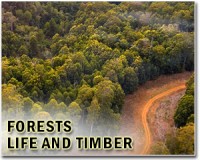| . |  |
. |
Washington DC (SPX) Mar 22, 2010 A new study involving scientists from 13 different organizations, universities and research institutions states that forest protection offers one of the most effective, practical, and immediate strategies to combat climate change. The study, "Indigenous Lands, Protected Areas, and Slowing Climate Change," was published in PLoS Biology, a peer-reviewed scientific journal, and makes specific recommendations for incorporating protected areas into overall strategies to reduce emissions of greenhouse gasses from deforestation and degradation (nicknamed REDD). "Deforestation leads to about 15 percent of the world's greenhouse gas emissions, more than all the cars, trucks, trains, ships, and planes on earth. If we fail to reduce it, we'll fail to stabilize our climate," said Taylor Ricketts, director of World Wildlife Fund's science program and lead author of the study. "Our paper emphasizes that creating and strengthening indigenous lands and other protected areas can offer an effective means to cut emissions while garnering numerous additional benefits for local people and wildlife." The authors highlight analyses showing that since 2002, deforestation in the Brazilian Amazon has been 7 to 11 times lower inside of indigenous lands and other protected areas than elsewhere. Simulation models suggest that protected areas established between 2003 and 2007 could prevent an estimated area of 100,000 square miles of deforestation through 2050. That is roughly the size of the state of Colorado, representing enough carbon to equal 1/3 of the world's annual CO2 emissions. Within these efforts, location matters; protected areas in regions that face deforestation pressures would be most effective at truly reducing emissions. "This study reinforces the wisdom behind global investments in protected areas," says Gustavo A.B. da Fonseca, co-author of the study and Team Leader Natural Resources of the Global Environment Facility (GEF). "In addition to protecting globally important species and ecosystems, the 2,302 protected areas supported by the GEF alone span over 634 million hectares and together store an impressive 30 billion tons of CO2" International policies for compensating forest nations for REDD are under active negotiation. To access the resulting funds, developing countries will need to develop programs and institutions to reduce forest emissions. "Protected areas represent a valuable component of national REDD programs since they already contain the necessary institutions and infrastructure to handle funds, strengthen protection and generate results," said Claudio Maretti, Conservation Director, WWF Brazil. "Establishing protected areas usually clarifies land tenure and the associated carbon rights, which has been a sticking point in some negotiations." In addition, the study estimates that the cost of creating and better managing protected areas is lower than many other options to reduce emissions from deforestation. Completing and managing a network of protected areas in the developing world might require $4 billion USD annually, which is roughly 1/10 of the capital that could be mobilized by international REDD policies. According to the study, forest nations can strengthen the role of protected areas in their REDD strategies by: + Identifying where Indigenous Lands and Protected Areas would most effectively reduce deforestation rates and associated emissions; + Establishing national monitoring to measure deforestation rates and quantify carbon emissions reductions; + Establishing insurance mechanisms for illegal logging or forest fires; + Providing indigenous groups and local communities the information and capacities they need to participate; + Distributing payments transparently to reward those responsible for reducing emissions. The publication "Indigenous Lands, Protected Areas, and Slowing Climate Change"
Share This Article With Planet Earth
Related Links World Wildlife Fund Forestry News - Global and Local News, Science and Application
 Indigenous Malaysians protest proposed land bill
Indigenous Malaysians protest proposed land billPutrajaya, Malaysia (AFP) March 17, 2010 Some 500 indigenous Malaysians on Wednesday mounted an unprecedented protest over a government bill they say will deprive them of land. Activists for the Orang Asli, the term for the native tribes in peninsular Malaysia, say the legislation expected to be tabled this July will give them only 50,000 hectares (123,550 acres) of the 129,000 they claim. "Who are you to give the land when it ... read more |
|
| The content herein, unless otherwise known to be public domain, are Copyright 1995-2010 - SpaceDaily. AFP and UPI Wire Stories are copyright Agence France-Presse and United Press International. ESA Portal Reports are copyright European Space Agency. All NASA sourced material is public domain. Additional copyrights may apply in whole or part to other bona fide parties. Advertising does not imply endorsement,agreement or approval of any opinions, statements or information provided by SpaceDaily on any Web page published or hosted by SpaceDaily. Privacy Statement |